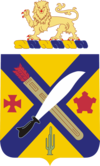2nd U.S. Infantry
| 2nd Infantry Regiment | |
|---|---|

|
|
| Founded | 1808 |
| Country |
|
| Branch |
|
| Type | Infantry |
| Role | 1st Bn — inactive 2nd Bn - light infantry |
| Part of |
|
| Garrison/HQ | 1st Bn — inactive 2nd Bn - Fort Polk, Louisiana |
| Nickname(s) | "Ramrods" |
| Motto(s) | "Noli Me Tangere" (Do Not Touch Me) |
| Engagements |
War of 1812 Indian Wars Mexican–U.S. War American Civil War War with Spain Philippine Insurection World War II Vietnam War War in Kosovo Global War on Terrorism |
| Commanders | |
| Notable commanders |
Hugh Brady Bennett C. Riley |
| Insignia | |
| Coat of arms | |
| U.S. Infantry Regiments | |
|---|---|
| Previous | Next |
| 1st Infantry Regiment | 3rd Infantry Regiment |
The 2nd Infantry Regiment is an infantry regiment in the United States Army that has served for more than two hundred years. It was constituted on 12 April 1808 as the 6th Infantry and consolidated with 4 other regiments in 1815 to form the present unit.
Although the original 2nd Infantry Regiment was constituted in March 1791 and fought in the Miami Indian Campaign and the War of 1812 at Fort Bowyer in Alabama its history and lineage is not a part of the present regiment. That regiment became part of the 1st Infantry through the consolidations of 1815.
At the end of the War of 1812 an act of Congress dated 3 March 1815 reduced the size of the Regular Army to a maximum of 10,000 men. Eight infantry regiments, one rifle regiment and an artillery regiment were formed from the remains of the 46 existing regiments, while the cavalry was eliminated. This was done with no regard for the traditions of the existing regiments. The old regiments which happened to be closest together were pooled to form new regiments and the numbers assigned the regiments were based on the seniority of the colonels commanding them.
In accordance with the act, on 17 May 1815 a new 2nd US Infantry was created by the consolidation of the 6th, 16th, 22nd, 23rd, and 32nd Regiments of Infantry, all then located in upper New York and Vermont. The date of organization of the present 2nd Infantry is that of the original 6th Infantry, 12 April 1808. The regiment's headquarters was in the cantonment at Sackett's Harbor. Colonel Hugh Brady became the regiment's commanding officer with Henry Leavenworth as major and Ninian Pinkney as lieutenant-colonel. The regimental number was "2" because Brady was the second most senior regimental commander in the United States Army. Colonel Brady was in command of the 22nd Infantry at the time of the consolidation and, though he served in several other commands and reached the rank of major general, he remained colonel commandant of the 2nd Infantry Regiment from his residence in Detroit until his death on 15 April 1851.
The War Department ruled that the present 2nd Infantry bear upon its colors the campaign honors of the regiments consolidated into its organization. Thus, the colors bear the campaign streamers for Canada, Chippawa and Lundy's Lane, even though the original/old 2nd Infantry did not participate in any of the battles in Canada during the War of 1812. The present 2nd Infantry also bears the two battle honors earned by the original/old 2nd Infantry for the Miami Campaign (1790-1795) and Alabama 1814.
In the ensuing years the regiment was primarily concerned with manning and constructing forts around the Great Lakes. When the Black Hawk War of 1832 erupted the 2nd Infantry was sent to Illinois but did not participate in any fighting. The regiment returned to its posts on the Great Lakes. During the Second Seminole War, from 1838 to 1842, the regiment was in Florida, where it was on the move daily, fighting and building roads and installations. In April 1840 with Colonel Brady attending to other duty assignments Lieutenant Colonel Bennett C. Riley assumed command of the regiment. Lieutenant Colonel Riley remained in command of the regiment until January 1850. In 1843 the regiment returned to its posts on Lakes Ontario and Champlain in upstate New York.
...
Wikipedia

